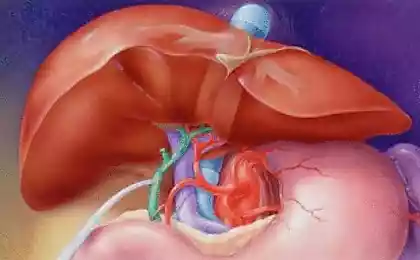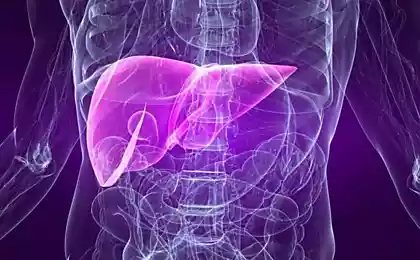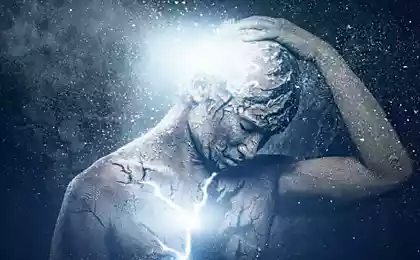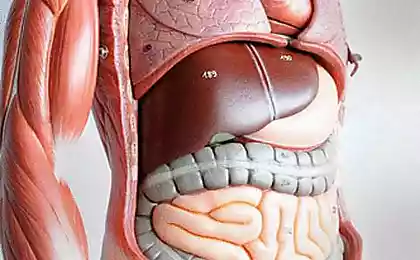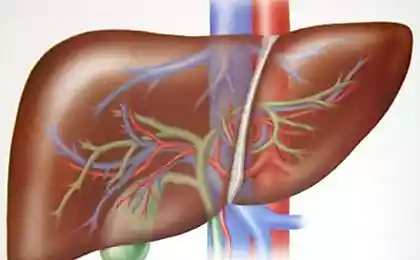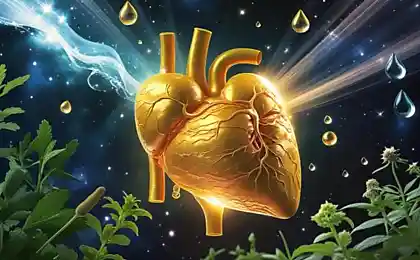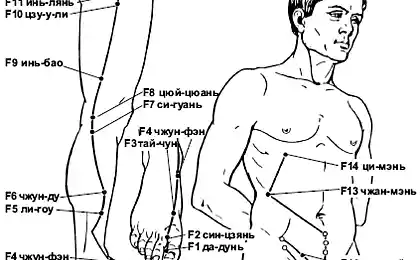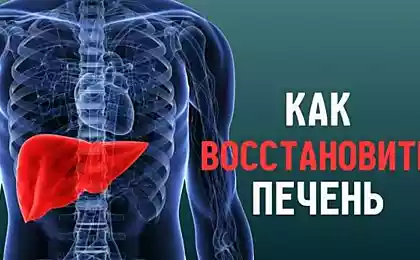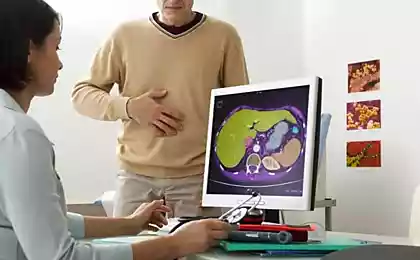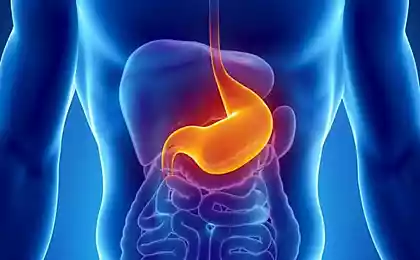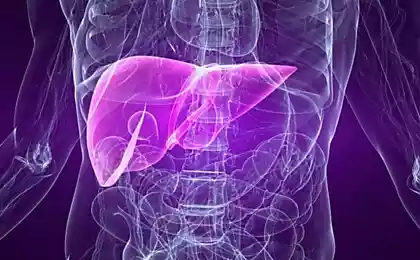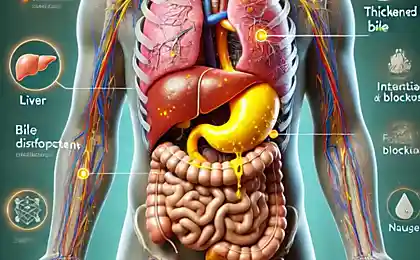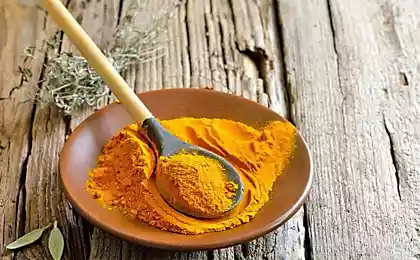484
The role of the liver in digestion that you didn'T KNOW
Of all organs the liver plays a Central role in the metabolism of proteins, fats, carbohydrates, vitamins, hormones and other substances. Its main functions are:
1. Antitoxic. It is neutralizing the toxic products formed in the large intestine caused by a bacterial putrefaction of proteins is the indole, skatole, and phenol. They, as well as exogenous toxic substances (alcohol) undergo biotransformation. (Eck-Pavlovskoye anastomosis).
2. The liver is involved in carbohydrate metabolism. It is synthesized and accumulated glycogen, and actively the processes of glycogenolysis and neoglucogenesis. Some of the glucose is used for the formation of fatty acids and glycoproteins.
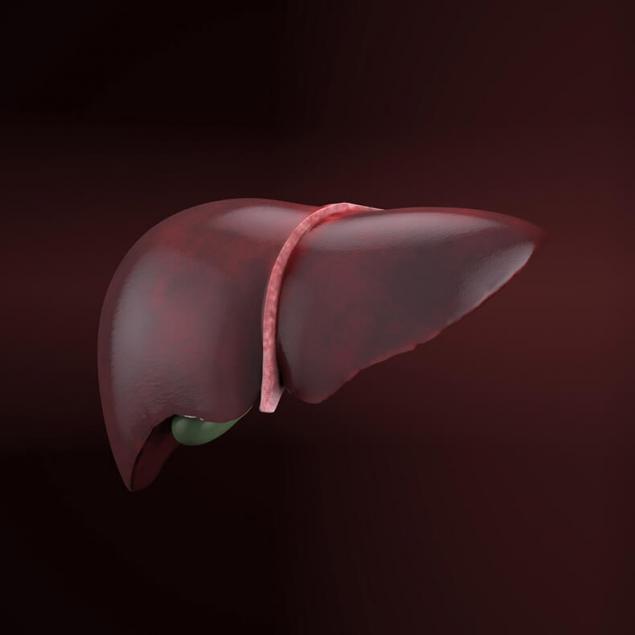
3. In the liver is deamination of amino acids, nucleotides and other nitrogen-containing compounds. The formed ammonia neutralized by synthesis of urea.
4. The liver is involved in fat metabolism. It converts short-chain fatty acids in higher. Formed in it, the cholesterol is used for synthesis of several hormones.
5. It synthesizes daily about 15 g of albumin, a1 – and a2-globulins, A2-globulins of the plasma.
6. The liver ensures the normal clotting of blood. a2-globulins are prothrombin, AC-globulin, convertin, antitrombina. In addition it is synthesized fibrinogen and heparin.
7. It inactivated hormones such as epinephrine, norepinephrine, serotonin, androgens and estrogens.
8. It is the main depot of vitamin A, b, D, E, K.
9. In it is deposited the blood, and is the destruction of erythrocytes with the formation of hemoglobin bilirubin.
10. Excretory. It allocates in the gastrointestinal tract is the cholesterol, bilirubin, urea, compounds of heavy metals.
11. In the liver formed the most important digestive juice – bile.
Bile produced by hepatocytes by active and passive transport of water, cholesterol, bilirubin, cations. In hepatocytes from cholesterol formation of primary bile acids – cholic and deoxycholic.
Of bilirubin and glucuronic acid synthesized water-soluble complex. They originate in the bile capillaries and ducts, where the bile acids combine with glycine and taurine. The result is taurocholate and glycocholic acid. Sodium bicarbonate is formed by using the same mechanisms as in the pancreas.
The bile produced by the liver continuously. Per day it produces about 1 liter. Hepatocytes is allocated a primary or hepatic bile. This liquid Golden-yellow alkaline reaction. PH = between 7.4 and 8.6. It consists of 97.5% water and 2.5% solids. The bottom line contains:
1. Minerals. The cations of sodium, potassium, calcium, bicarbonate, phosphate anions, anions of chlorine.
2. Bile acids – glycocholic and taurocholate.
3. Bile pigments – bilirubin and its oxidative form biliverdin. Bilirubin gives bile color.
4. Cholesterol and fatty acids.
5. Urea, uric acid, creatinine.
6. The mucin.
Since the digestion of the sphincter of Oddi, located at the mouth of the common bile duct, closed, eye-catching bile accumulates in the gallbladder. Here it is reabsorbed the water, and the contents of the main organic components and mucin increases 5-10 times. Therefore, gallbladder bile contains 92% water and 8% solids. It is more dark, dense and viscous than the liver. Due to this concentration, the bubble can accumulate bile within 12 hours. During digestion open the sphincter of Oddi and the sphincter of Lutkens in the neck of the bladder. The bile goes into the duodenum.
The value of bile:
1. The bile acid emulsified fat part, turning large fat particles into fine droplets.
2. It activates the enzymes of pancreatic and intestinal juice, especially lipase.
3. In complex with bile acids the absorption of long-chain fatty acids and fat-soluble vitamins through the membrane of enterocytes.
4. Bile facilitates the resynthesis of triglycerides in enterocytes.
5. Inactivates pepsin and neutralizes the acidic chyme coming from the stomach. This ensures that the transition from gastric to intestinal digestion.
6. Stimulates the secretion of pancreatic and intestinal juices, as well as the proliferation and sloughing of enterocytes.
7. Enhances intestinal motility.
8. Has bacteriostatic effect on microorganisms in the intestine and thus prevents the development of putrefactive processes in it.
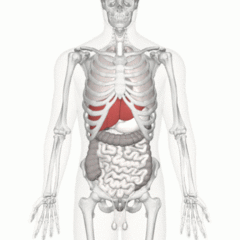
Regulation of bile production and bile excretion is mainly humoral mechanisms, although some role play and nervous. The most powerful stimulant of bile in the liver are bile acids absorbed into the bloodstream from the intestines. It also enhances secretin, which increases the amount of bile sodium bicarbonate. The vagus nerve stimulates the production of bile, sympathetic brake.
With the entry of chyme into the duodenum starts the allocation of the I-cells of its mucosa cholecystokinin-pankreozimin. Especially this process is stimulate the fats, egg yolk and magnesium sulfate. Htsk-PZ strengthens the contraction of smooth muscles of bladder, bile ducts, but relaxes the sphincter of Oddi and Lutkens.
The bile released into the intestine. Reflex mechanisms play a limited role. Chyme irritate the chemoreceptors of the small intestine. Impulses from them enter the digestive center of the medulla oblongata. From him they the vagus to the biliary ways. The sphincters relax, and the smooth muscle of the bladder is reduced. This contributes to delchevalerie.
In the experiment, the bile production and delchevalerie are investigated in chronic experiments by superimposing a fistula of the common bile duct or bladder. In the clinic for the study of biliary excretion using duodenal intubation, x-rays with the introduction into the bloodstream of radiopaque substances bilitrast, ultrasonic methods. Belkovosvazavatei liver function, its contribution in fat, carbohydrate, pigment exchanges study by examining various indicators of blood. For example, determine the content of total protein, prothrombin, antithrombin, bilirubin, enzymes.
5 the achievements of civilization, which spoil your life
This simple procedure will remove sagging face and bleached teeth
The most serious diseases are hepatitis and cirrhosis of the liver. Often the hepatitis are the result of infections (the infectious hepatitis A, b, C) and exposure to toxic products (alcohol). Hepatitis affects the hepatocytes and violated all the functions of the liver. Cirrhosis is the outcome of the hepatitis. The most frequent violation bile is cholelithiasis. The bulk of the gallstones formed with cholesterol, because the bile of these patients is oversaturated with Them.published
P. S. And remember, only by changing their consumption — together we change the world! ©
Source: human-physiology.ru/funkcii-pecheni-rol-pecheni-v-pishhevarenii/
1. Antitoxic. It is neutralizing the toxic products formed in the large intestine caused by a bacterial putrefaction of proteins is the indole, skatole, and phenol. They, as well as exogenous toxic substances (alcohol) undergo biotransformation. (Eck-Pavlovskoye anastomosis).
2. The liver is involved in carbohydrate metabolism. It is synthesized and accumulated glycogen, and actively the processes of glycogenolysis and neoglucogenesis. Some of the glucose is used for the formation of fatty acids and glycoproteins.

3. In the liver is deamination of amino acids, nucleotides and other nitrogen-containing compounds. The formed ammonia neutralized by synthesis of urea.
4. The liver is involved in fat metabolism. It converts short-chain fatty acids in higher. Formed in it, the cholesterol is used for synthesis of several hormones.
5. It synthesizes daily about 15 g of albumin, a1 – and a2-globulins, A2-globulins of the plasma.
6. The liver ensures the normal clotting of blood. a2-globulins are prothrombin, AC-globulin, convertin, antitrombina. In addition it is synthesized fibrinogen and heparin.
7. It inactivated hormones such as epinephrine, norepinephrine, serotonin, androgens and estrogens.
8. It is the main depot of vitamin A, b, D, E, K.
9. In it is deposited the blood, and is the destruction of erythrocytes with the formation of hemoglobin bilirubin.
10. Excretory. It allocates in the gastrointestinal tract is the cholesterol, bilirubin, urea, compounds of heavy metals.
11. In the liver formed the most important digestive juice – bile.
Bile produced by hepatocytes by active and passive transport of water, cholesterol, bilirubin, cations. In hepatocytes from cholesterol formation of primary bile acids – cholic and deoxycholic.
Of bilirubin and glucuronic acid synthesized water-soluble complex. They originate in the bile capillaries and ducts, where the bile acids combine with glycine and taurine. The result is taurocholate and glycocholic acid. Sodium bicarbonate is formed by using the same mechanisms as in the pancreas.
The bile produced by the liver continuously. Per day it produces about 1 liter. Hepatocytes is allocated a primary or hepatic bile. This liquid Golden-yellow alkaline reaction. PH = between 7.4 and 8.6. It consists of 97.5% water and 2.5% solids. The bottom line contains:
1. Minerals. The cations of sodium, potassium, calcium, bicarbonate, phosphate anions, anions of chlorine.
2. Bile acids – glycocholic and taurocholate.
3. Bile pigments – bilirubin and its oxidative form biliverdin. Bilirubin gives bile color.
4. Cholesterol and fatty acids.
5. Urea, uric acid, creatinine.
6. The mucin.
Since the digestion of the sphincter of Oddi, located at the mouth of the common bile duct, closed, eye-catching bile accumulates in the gallbladder. Here it is reabsorbed the water, and the contents of the main organic components and mucin increases 5-10 times. Therefore, gallbladder bile contains 92% water and 8% solids. It is more dark, dense and viscous than the liver. Due to this concentration, the bubble can accumulate bile within 12 hours. During digestion open the sphincter of Oddi and the sphincter of Lutkens in the neck of the bladder. The bile goes into the duodenum.
The value of bile:
1. The bile acid emulsified fat part, turning large fat particles into fine droplets.
2. It activates the enzymes of pancreatic and intestinal juice, especially lipase.
3. In complex with bile acids the absorption of long-chain fatty acids and fat-soluble vitamins through the membrane of enterocytes.
4. Bile facilitates the resynthesis of triglycerides in enterocytes.
5. Inactivates pepsin and neutralizes the acidic chyme coming from the stomach. This ensures that the transition from gastric to intestinal digestion.
6. Stimulates the secretion of pancreatic and intestinal juices, as well as the proliferation and sloughing of enterocytes.
7. Enhances intestinal motility.
8. Has bacteriostatic effect on microorganisms in the intestine and thus prevents the development of putrefactive processes in it.

Regulation of bile production and bile excretion is mainly humoral mechanisms, although some role play and nervous. The most powerful stimulant of bile in the liver are bile acids absorbed into the bloodstream from the intestines. It also enhances secretin, which increases the amount of bile sodium bicarbonate. The vagus nerve stimulates the production of bile, sympathetic brake.
With the entry of chyme into the duodenum starts the allocation of the I-cells of its mucosa cholecystokinin-pankreozimin. Especially this process is stimulate the fats, egg yolk and magnesium sulfate. Htsk-PZ strengthens the contraction of smooth muscles of bladder, bile ducts, but relaxes the sphincter of Oddi and Lutkens.
The bile released into the intestine. Reflex mechanisms play a limited role. Chyme irritate the chemoreceptors of the small intestine. Impulses from them enter the digestive center of the medulla oblongata. From him they the vagus to the biliary ways. The sphincters relax, and the smooth muscle of the bladder is reduced. This contributes to delchevalerie.
In the experiment, the bile production and delchevalerie are investigated in chronic experiments by superimposing a fistula of the common bile duct or bladder. In the clinic for the study of biliary excretion using duodenal intubation, x-rays with the introduction into the bloodstream of radiopaque substances bilitrast, ultrasonic methods. Belkovosvazavatei liver function, its contribution in fat, carbohydrate, pigment exchanges study by examining various indicators of blood. For example, determine the content of total protein, prothrombin, antithrombin, bilirubin, enzymes.
5 the achievements of civilization, which spoil your life
This simple procedure will remove sagging face and bleached teeth
The most serious diseases are hepatitis and cirrhosis of the liver. Often the hepatitis are the result of infections (the infectious hepatitis A, b, C) and exposure to toxic products (alcohol). Hepatitis affects the hepatocytes and violated all the functions of the liver. Cirrhosis is the outcome of the hepatitis. The most frequent violation bile is cholelithiasis. The bulk of the gallstones formed with cholesterol, because the bile of these patients is oversaturated with Them.published
P. S. And remember, only by changing their consumption — together we change the world! ©
Source: human-physiology.ru/funkcii-pecheni-rol-pecheni-v-pishhevarenii/
How to make homemade tarragon: drink recipe
Acura showed a concept electric supercar NSX on the basis of

